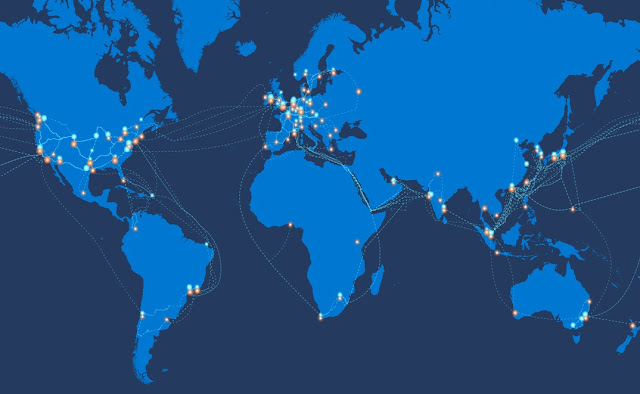 |
| Backbone Network Services |
Over the past few decades there has been an explosion of internet connectivity
across the world as more and more people and businesses go online. This
exponential growth of internet traffic flowing across countries and continents
would not be possible without robust backbone network services that form the core
infrastructure of the global internet. In this article, we will explore what
backbone network services are, their importance, key players and the recent
trends shaping their future growth and development.
What are Backbone Network Services?
A backbone network refers to the main element of any telecommunications network
that interconnects various parts of the network and enables data transmission
between different nodes. Backbone network services typically involve
high-capacity digital telecommunications channels and networking equipment that
facilitate internet traffic routing across vast geographical regions and
international borders.
Some key characteristics of backbone network services include:
- High-bandwidth connectivity - Backbone networks use dense wavelength-division
multiplexing (DWDM) and other advanced technologies to carry huge volumes of
data traffic at very high speeds.
- Connectivity between internet exchange points - Backbones physically connect
multiple internet exchange points (IXPs) that interface with other networks for
efficient traffic routing.
- Resilience - Redundant paths and diverse routes ensure backbone networks
remain operational even if one link or component fails to avoid internet
disruptions.
- Global reach - Major Backbone
Network Services have point of presence (PoPs) in most countries and
continents to facilitate international data transmission.
- Carrier-neutrality - Backbone operators remain neutral third-party operators
rather than directly catering to end-users.
Why are Backbone Services Critical?
Reliable backbone networks are the lifeblood of today's global internet
ecosystem. They play a vital role in enabling wide-scale data connectivity,
online businesses, cloud services, content delivery and a multitude of other
bandwidth intensive applications that have become integral to our daily lives
and economies. Some of the key reasons backbone networks are so important
include:
- Facilitate global data flows - Without robust backbones, the huge amounts of
data traveling across borders for emails, downloads, streaming, etc would not
be possible.
- Interconnection between ISPs - Backbones provide the physical interconnection
between internet service providers (ISPs) worldwide for seamless traffic
exchange.
- Underpin cloud & content delivery - Services like cloud computing, video
streaming heavily rely on low latency backbone routes for fast content distribution
globally.
- Resilience - Redundant backbone infrastructure ensures internet continuity
even during outages along specific routes or failure of equipment.
- enable new applications - Emerging technologies like IoT, telemedicine,
remote work depend on high-bandwidth low-latency backbones for realizing their
full potential.
Major Backbone Network Service Providers
A few companies have built global scale next-generation backbone networks and
infrastructure over the past few decades through heavy investments. Some of the
biggest international backbone providers include:
- AT&T - One of the oldest and largest US telecom companies operating a
Tier 1 global IP backbone spanning 60+ countries.
- Verizon - Another US-based provider with an expansive global IP network
across six continents and submarine cable investments.
- NTT - A leading Japanese telecom with an extensive global IP network
including key Asian and trans-Pacific routes.
- Telegeography - A private network operator servicing major content and cloud
providers with low latency routes worldwide.
- GTT Communications - A fast growing player with a focus on cloud connectivity
and internet exchange-based ethernet backhaul services.
- Zayo Group - A key provider of bandwidth infrastructure like fiber networks
and dedicated internet access in North America and Europe.
- China Telecom - China's largest state-owned operator extends its domestic
infrastructure beyond Chinese borders.
Emerging Trends in Backbone Services
With bandwidth requirements growing exponentially, backbone networks are
evolving to stay ahead of demand. Here are some emerging trends impacting
backbone services:
- Subsea cables - Ongoing investments into new subsea cable systems is
dramatically improving connectivity across oceans. The new cables incorporate
high core count fiber optic cables and maximize bandwidth potential.
- Co-location centers & cloud exchanges - Edge infrastructure deployments
near major population hubs reduce latencies for content distribution. Backbone
operators are partnering with cloud/IX giants for co-location centers.
- Ethernet backhauling - For the final connectivity miles into cellular base
stations, metro backbones have moved from TDM to Ethernet-based packet
transport to seamlessly integrate IP/data infrastructure.
- Software defined networks - Technologies like network functions
virtualization (NFV), SDN enable agile changes to backbone architectures.
Logical topology can be altered without physical configuration changes for
smart traffic engineering.
- Network as a Service - Managed internet services and various types of
enterprise connectivity offerings are gaining popularity among businesses
looking for flexible scalable networking solutions.
- AI/ML for predictive analytics - Telecom operators are using AI/ML techniques
to analyze traffic trends, fault patterns to optimize network resource
utilization and preempt issues for improved QoS.
In today's hyperconnected world riding on the digital revolution, ubiquitous
high-speed low-latency networking has become as important as other basic
utilities. Backbone network service providers continue to evolve their
infrastructure to power this transformation by staying at the cutting edge of
new technologies. Their role in enabling uninterrupted connectivity globally
will become only more crucial in the coming years.
Get More Insights On This Topic: Backbone
Network Services
